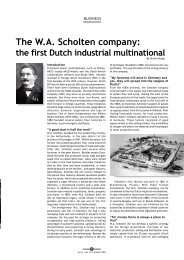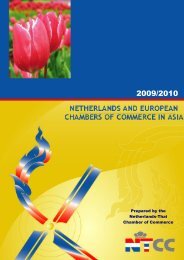December 2009 / January 2010 - Association of Dutch Businessmen
December 2009 / January 2010 - Association of Dutch Businessmen
December 2009 / January 2010 - Association of Dutch Businessmen
You also want an ePaper? Increase the reach of your titles
YUMPU automatically turns print PDFs into web optimized ePapers that Google loves.
Special<br />
The Little Red Book<br />
By Richard Soemita<br />
Quotations from Chairman Mao Zedong, better known in the West as The Little Red<br />
Book, was published by the Government <strong>of</strong> the People’s Republic <strong>of</strong> China from April<br />
1964 until approximately 1976. As its title implies, it is a collection <strong>of</strong> quotations excerpted<br />
from Mao Zedong’s past speeches and publications. The book’s alternative title The Little Red<br />
Book was coined by the West for its pocket-sized edition, which was specifically printed and<br />
sold to facilitate easy carrying. The closest equivalent in Chinese is, literally “The Red Treasured<br />
Book”, which was a term popular during the Cultural Revolution.<br />
The most printed book in the twentieth century, Quotations had an estimated 5 to 6.5 billion<br />
copies printed during Mao’s attempt to transform Chinese society. The book’s phenomenal<br />
popularity may be due to the fact that it was essentially an un<strong>of</strong>ficial requirement for every<br />
Chinese citizen to own, to read, and to carry it at all times during the later half <strong>of</strong> Mao’s rule,<br />
especially during the Cultural Revolution.<br />
During the Cultural Revolution, studying the book was not only required in schools but was<br />
also a standard practice in the workplace as well. All units, in the industrial, commercial, agricultural,<br />
civil service, and military sectors, organized group sessions for the entire workforce to study the book<br />
during working hours. Quotes from Mao were either bold-faced or highlighted in red, and almost all<br />
writing, including scientific essays, had to quote Mao.<br />
To defend against the theory that it would be counter-productive, it was argued that understanding<br />
Mao’s quotes could definitely bring about enlightenment to the work unit, resulting in production<br />
improvement to <strong>of</strong>fset the time lost.<br />
During the 1960s, the book was the single most visible icon in mainland China, even more visible<br />
than the image <strong>of</strong> the Chairman himself. In posters and pictures created by CPC’s propaganda artists,<br />
nearly every painted character, except Mao himself, either smiling or looking determined, was always<br />
seen with a copy <strong>of</strong> the book in his or her hand.<br />
After the end <strong>of</strong> the Cultural Revolution in 1976 and the rise <strong>of</strong> Deng Xiaoping in 1978, the importance<br />
<strong>of</strong> the book waned considerably, and the glorification <strong>of</strong> Mao’s quotations was considered to be left<br />
deviationism and a cult <strong>of</strong> personality. The original books now became a collector’s item and some<br />
editions are highly sought after. The book has been translated in many languages, even in <strong>Dutch</strong> and<br />
was first published in 1967 by A.W.Bruna & Zonen.<br />
Mao’s quotations are categorized into 33 chapters in the book. Its topics mainly deal with Mao’s<br />
ideology, known in the West as Maoism and <strong>of</strong>ficially as “Mao Zedong Thought.”<br />
25<br />
Vol.19 • No. 10 • <strong>December</strong> <strong>2009</strong> / <strong>January</strong> <strong>2010</strong>
















